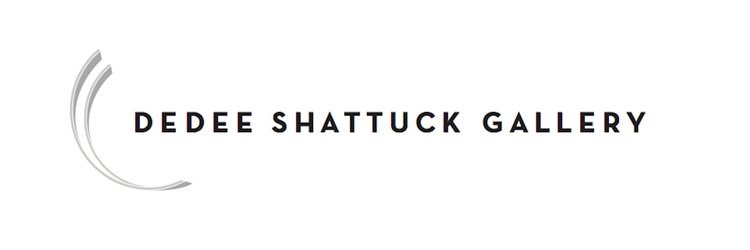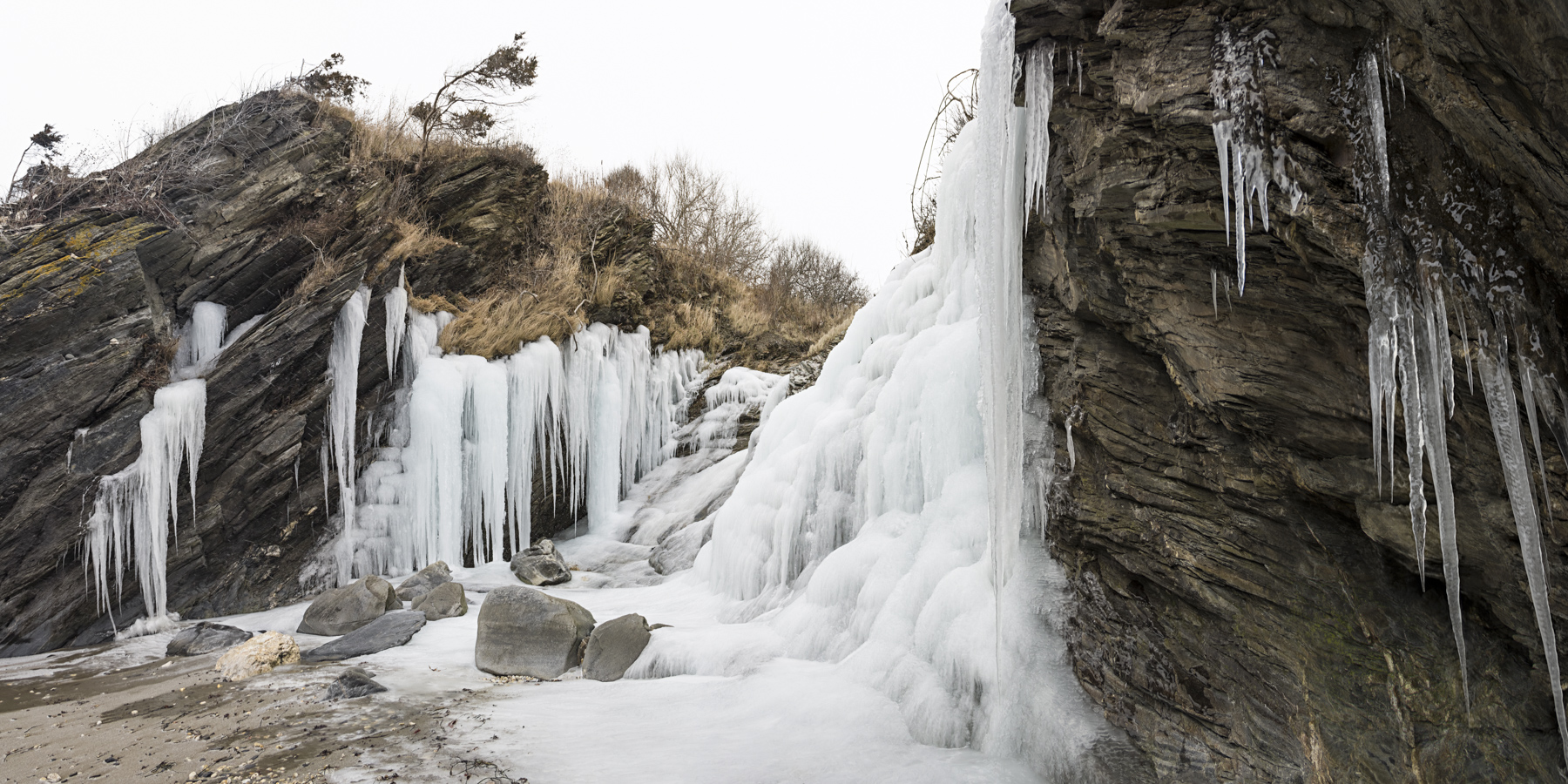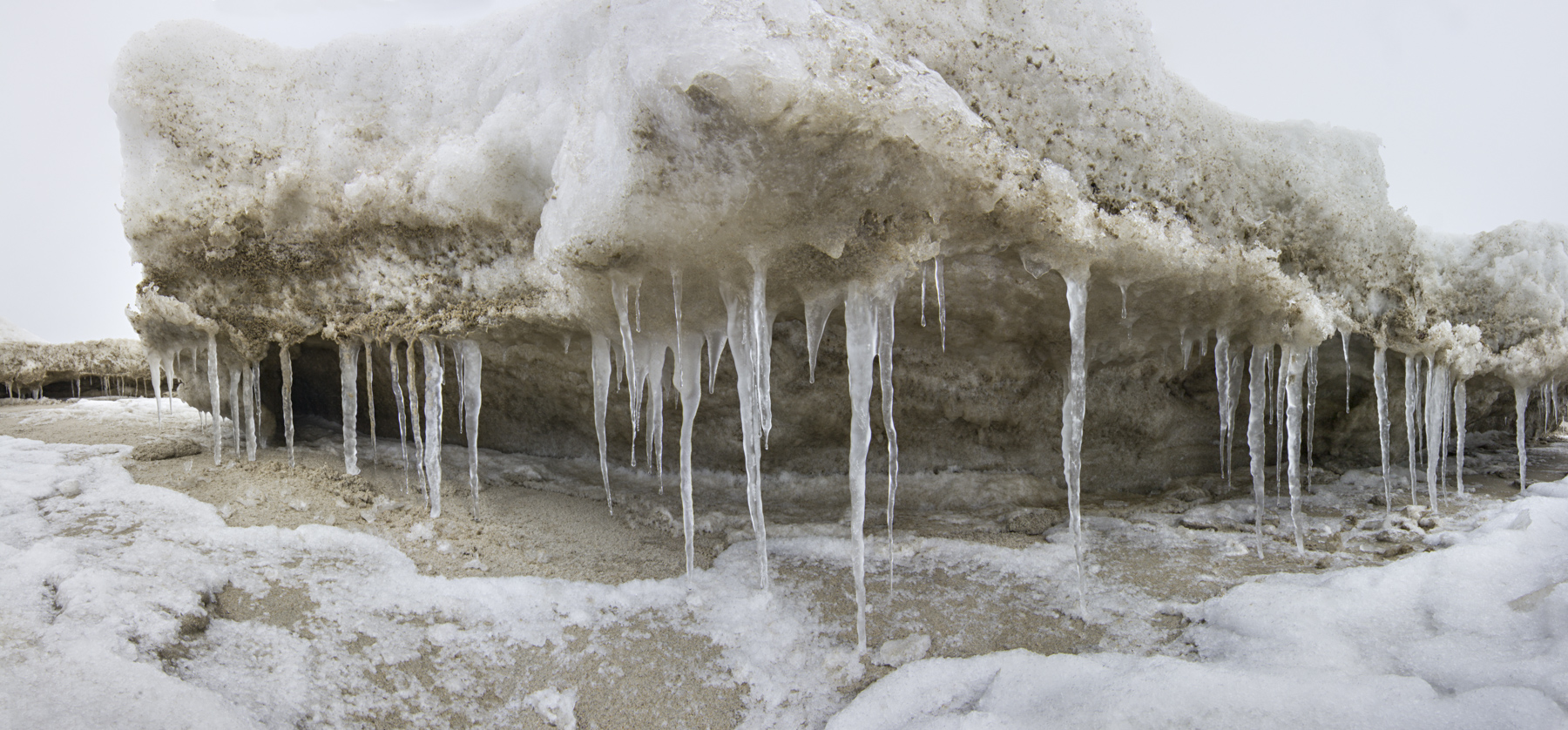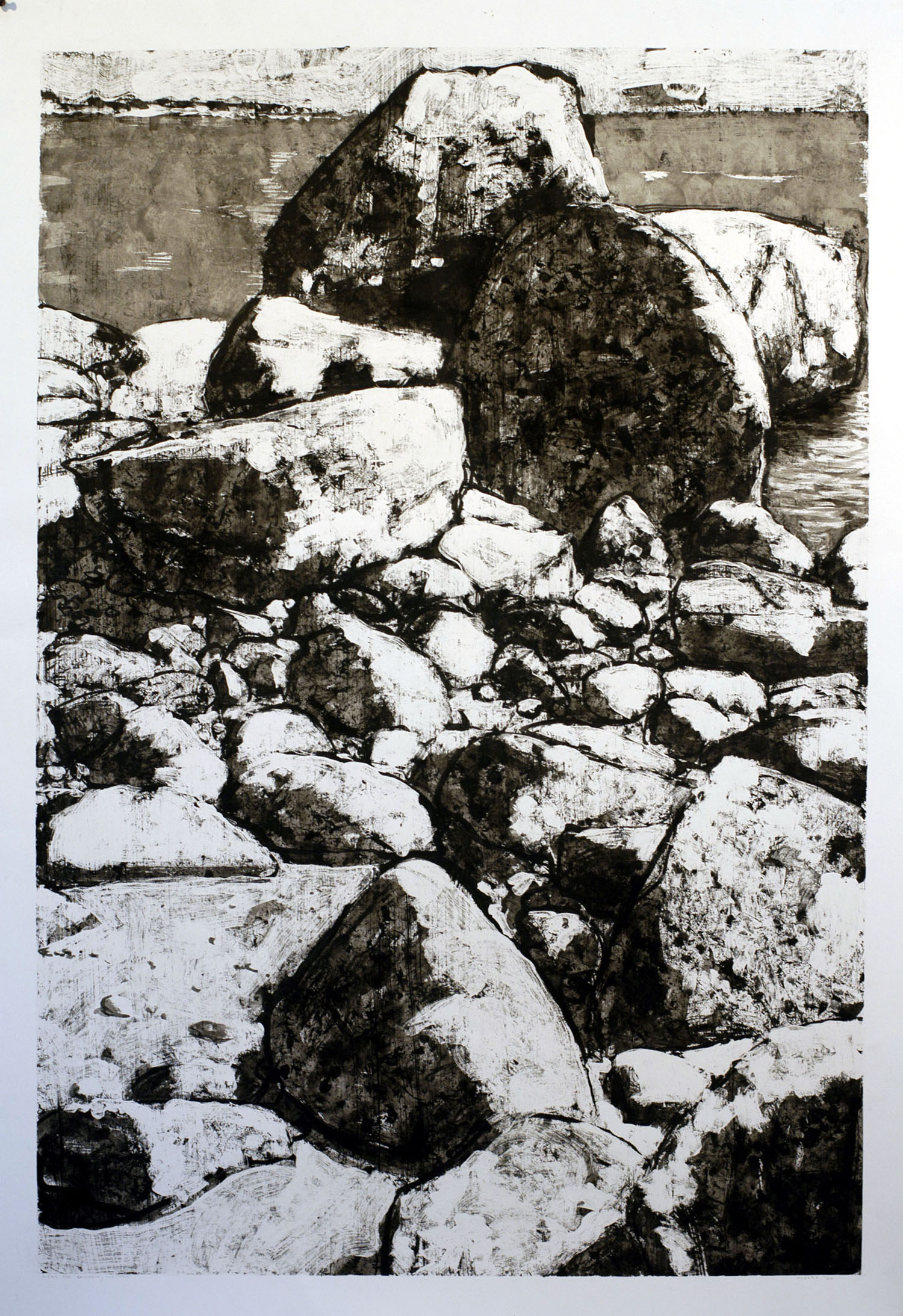July 6 - 28
Opening Reception
Saturday July 6, 5-7pm
" There is the very peculiar manner in which our minds interact with the world, based on memory and tentative anticipation of the future."
Virginia Wolf
"Traces of Time" considers the artifacts of places, both specific and psychological.
Through sculpture (Fishman), painting (Moore), and photography (Sharlin), these investigations encompass questions on the nature of permanence, the ephemeral, scale, experience, and time. A shared connection to geology is where the idiosyncratic works of these artists meet and diverge.
Our regional landscapes and shorelines are defined by ledges, outcroppings, erratic boulders and field stones composed of granite, sandstone, puddingstone, and slate. This basic material of the earth has been crushed, submerged, exposed, scraped, and eroded. It has been melted, re-formed, exploded and buried by vast forces of pressure and heat and ice over incomprehensible measures of time. These actions are readily apparent in the abrasions, striations, folds, and cracks of the glacial shards and litter scattered throughout this area.
These geologic features anchor locations that are familiar. Their apparently obdurate stability is based on our brief sense of the passing of time, though attention reveals constant motion and change. Boulders on a beach are undercut by wave action and move. Ice in a fissure can fracture an outcrop. Smaller stones grind and wear, polished by sand and water. Such a shift in awareness informs a psychological and metaphorical dimension that is reflected in the materials, processes, and imagery of these artworks. They reference a core substance, perhaps suggestive of the alchemists' prima materia, perhaps as a projection of the unconscious. The material is pulled by the weight of the earth, seemingly of an opaque density. Yet the temporal, the transient and passing is always present. These activities, both geological and artistic, are palpable and inexorable.
Jonathan Sharlin
Biography
Jonathan Sharlin has approached photography from many angles over his 45 year career. He has incorporated the medium in a variety of ways, from photo-drawings to photographic installations. Each series a process of discovery, distillation and commentary on issues of personal importance.
For over 30 years a Rhode Island native, Jon has been the recipient of over 10 grants from the Rhode Island Council for the Arts, in addition to grants from the Rhode Island Foundation and NEFA. (New England Foundation for the Arts). His books include ‘Cast a Cold Eye’, (an end of life transcript of his mother) Cyan Press 2008. His recent 2016 Blue Sky publication, ‘Ancient Stones of Scotland’ has a forward by Jo-Ann Conklin Director of Brown University’s David Winton Bell Gallery. He is currently working on a book of images taken over a 25 year period in the Upper Peninsula of Michigan, (‘From a Small Island’).
Jon received his BA from Goddard College and his MFA from Visual Studies Workshop. He has taught at numerous colleges, including Tufts, Rhode Island College, Roger Williams University and RISD. His work is included in a number of public and private collections, including the Fogg Museum, the MFA of Houston, RISD Museum, the Polaroid Collection, Fidelity Collection, Rose Art Museum, and Brown University.
Artist Statement: An Unsure Winter
I speak to you now with the land's voice,
It is the cold, wild land that says to you
A knowledge glimmers in the sleep of things
A Spell Before Winter, Howard Nemerov
Winter: a time of solace and contemplation. Frigid with ice and snow, darkness comes early. An avid outdoorsman, I am drawn to winter’s stark, harsh, ephemeral beauty. Seven years ago, the Great Lakes were frozen solid, a rare occurrence. I went north that winter, after having spent the last 25 summers photographing in the area. The experience was raw, intense and visually stunning. From that point on, I continued to shoot during the winters, focusing my lens closer to home.
However, the past few winters have been unnaturally mild. It has become more of a challenge to find the drama of ice and snow. Trees have budded in January and temperatures fluctuate wildly. The sustained hibernation of plant and animal life must be difficult under such circumstances.
As our world warms, will the sleep of winter disappear?
-
Technical information:
Every photograph in the exhibit is a composite of roughly 12 to 20 separate images stitched together post capture in the computer.
Throughout my career I’ve predominately worked with BxW film and enjoyed the craft of printing in the darkroom. This new body of work is not only a technical departure, but also changes the experience of visualizing and interpreting my experience. The plasticity of digital photography has enabled me to stretch analog limitations. All limited edition prints are archival inkjet prints on Canson rag.
Todd Moore
Biography
Todd Moore is a graduate of the Rhode Island School of Design (MFA Painting) and The Evergreen State College, Olympia, WA (BA). He is a painter who has exhibited his work nationally in over 35 galleries and museums since the 1970s. He is also a Professor of Design in the Division of Experimental & Foundation Studies at RISD, where he has taught since 1985. He lives and maintains his studio practice in Tiverton, Rhode Island.
Artist Statement
These paintings and ink drawings were not developed to be about time, but that is what they have become.
The encounter with and memory of a place generates a painting or a drawing, starting with marks, perhaps with color, an image, a composition. A reference may develop. Accretion and repetition occurs.
These are depictions from the local coastal waterways and shorelines of Rhode Island and Massachusetts. They span a period exploring these scenes, these solitary locations. They are parts of a series. They are documentary. They are of the most basic features- rocks, water, sky.
Landscape painting calls attention to its artifice due to its limitations as an imitation of the physical world. Or, more precisely, as a reference to a sensation. The pieces are relatively static, but the understanding is not. Everything- the motif, the circumstance, the context, the viewer- is in constant flux. These elements, and so the experiences, are situated in a paradoxical state. Rest and motion, calm and unease, enclosure and escape. In retrospect they are nostalgic, perhaps elegaic.
Carlo Rovelli, the physicist who wrote "The Order of Time", posits that time is not linear, that reality is just a complex network of events, a gravitational field onto which we project sequences of past, present and future. There is no past or future; we only experience it this way. Time is an illusion: our perception of its flow doesn’t correspond to physical reality. However, time is central to our experience — that having a now is what constitutes having an experience at all. We always live at a specific moment, remembering the past and waiting for the future.
Richard Fishman
Biography
Richard Fishman is a sculptor and designer whose work is represented in numerous private and public collections including the Hirshhorn Museum and Sculpture Garden, the Skirball Museum, the Rose Art Museum, Brandies University, and the Massachusetts Institute of Technology. Over the course of his career he has had 28 one-person exhibitions, more than 50 group exhibitions, and is the recipient of many awards including a Howard Foundation award and the John Simon Guggenheim Foundation Fellowship. Fishman is a Professor Emeritus at Brown University and was the Founding Director of the Granoff Center for the Creative Arts where he was instrumental in creating interdisciplinary initiatives between the arts, science, and technology.
ARTIST STATEMENT
The sculptures in this exhibition were all made in the past year. I’m at the edge of understanding what they mean to me.
I ask myself if behavioral characteristics can be communicated through material transformation.
I collect all manner of natural and man-made things. My shelves are filled with the remnants of birds, plants, skeletal remains, minerals and medical instruments designed by “quack” doctors. Over time, the affinities between disparate elements reveal themselves and create paths to new discoveries. . I am drawn to the tactile quality of minerals. Jagged, smooth, dripping, modified by the elements and the passage of time.
I discovered that I could capture some characteristic of minerals by applying extreme heat to expanded polystyrene. I began to push the material beyond its limits. Eventually I could control and shape it with relative ease simultaneously becoming aware of the inherent danger in making these objects. My thoughts go to the oceans of plastic trash choking our planet. It’s time to stop.
Like much of my work these sculptures developed from a search for meaning. I am driven by an inherent curiosity about the extremes of nature and the nature of extremes. I try to push materials to their limits knowing that going too far is the only way to know how far you can go.























